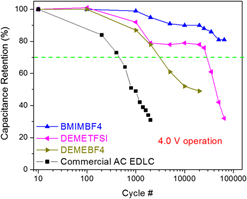Crossref Citations
This article has been cited by the following publications. This list is generated based on data provided by
Crossref.
Mahanta, Upasana
Kundu, Debashis
Venkatesh, R. Prasanna
Sujatha, S.
Ilangovan, S. A.
and
Banerjee, Tamal
2019.
Electrochemical Performance and Molecular Structure of Diluted 1-Alkyl-3-methylimidazolium Tetrafluoroborate Ionic Liquids and Their Mixture as Electrolytes for Double-Layer Capacitors: An Integrated Approach by Electrochemical Characterization and Molecular Dynamics Simulation.
Industrial & Engineering Chemistry Research,
Vol. 58,
Issue. 51,
p.
22741.
Martinez-Ligas, J.
Oliva, A.I.
Velazquez-Manzanares, M.
Garcia, C.R.
Mtz-Enriquez, A.I.
and
Oliva, J.
2019.
Enhancing the capacitance/discharge times of flexible graphene supercapacitors with ionic liquid/Li electrolytes.
Materials Letters,
Vol. 253,
Issue. ,
p.
205.
Horn, Michael
MacLeod, Jennifer
Liu, Meinan
Webb, Jeremy
and
Motta, Nunzio
2019.
Supercapacitors: A new source of power for electric cars?.
Economic Analysis and Policy,
Vol. 61,
Issue. ,
p.
93.
Schutjajew, Konstantin
Yan, Runyu
Antonietti, Markus
Roth, Christina
and
Oschatz, Martin
2019.
Effects of Carbon Pore Size on the Contribution of Ionic Liquid Electrolyte Phase Transitions to Energy Storage in Supercapacitors.
Frontiers in Materials,
Vol. 6,
Issue. ,
Kang, Dong A.
Kim, Kihoon
Karade, Swapnil S.
Kim, Hansung
and
Hak Kim, Jong
2020.
High-performance solid-state bendable supercapacitors based on PEGBEM-g-PAEMA graft copolymer electrolyte.
Chemical Engineering Journal,
Vol. 384,
Issue. ,
p.
123308.
Likitchatchawankun, Ampol
Whang, Grace
Lau, Jonathan
Munteshari, Obaidallah
Dunn, Bruce
and
Pilon, Laurent
2020.
Effect of temperature on irreversible and reversible heat generation rates in ionic liquid-based electric double layer capacitors.
Electrochimica Acta,
Vol. 338,
Issue. ,
p.
135802.
Wong, Shao Ing
Lin, Han
Sunarso, Jaka
Wong, Basil T.
and
Jia, Baohua
2020.
Optimization of ionic-liquid based electrolyte concentration for high-energy density graphene supercapacitors.
Applied Materials Today,
Vol. 18,
Issue. ,
p.
100522.
Biegun, Marcin
Dymerska, Anna
Chen, Xuecheng
and
Mijowska, Ewa
2020.
Study of the Active Carbon from Used Coffee Grounds as the Active Material for a High-Temperature Stable Supercapacitor with Ionic-Liquid Electrolyte.
Materials,
Vol. 13,
Issue. 18,
p.
3919.
Hu, Yuan
Brahim, Sean
Maat, Stefan
Davies, Patricia
Kundu, Arpan
and
Fisher, Timothy S.
2020.
Rapid Analytical Instrumentation for Electrochemical Impedance Spectroscopy Measurements.
Journal of The Electrochemical Society,
Vol. 167,
Issue. 2,
p.
027545.
Li, Yi-Chiun
and
Lin, Lu-Yin
2020.
Novel pseudo-parallel activated carbon/carbon cloth electrodes connected in novel series for flexible symmetric supercapacitor with enlarged potential window.
Electrochimica Acta,
Vol. 363,
Issue. ,
p.
137275.
Aydogan Gokturk, Pinar
and
Suzer, Sefik
2021.
Probing the Dynamics of Non-Faradaic Processes in Ionic Liquids at Extended Time and Length Scales Using XPS with AC Modulation.
The Journal of Physical Chemistry C,
Vol. 125,
Issue. 17,
p.
9453.
Lethesh, Kallidanthiyil Chellappan
Bamgbopa, Musbaudeen O.
and
Susantyoko, Rahmat Agung
2021.
Prospects and Design Insights of Neat Ionic Liquids as Supercapacitor Electrolytes.
Frontiers in Energy Research,
Vol. 9,
Issue. ,
Kuusik, Ivar
Kook, Mati
Pärna, Rainer
and
Kisand, Vambola
2021.
Ionic Liquid Vapors in Vacuum: Possibility to Derive Anodic Stabilities from DFT and UPS.
ACS Omega,
Vol. 6,
Issue. 8,
p.
5255.
Zhang, Xi'ai
Yuan, Rong
Pan, Duo
Zhong, Rui
Wang, Tong
You, Changyu
Zhang, Weijun
Wang, Fei
and
Zhu, Hao
2021.
Controllable one-pot hydrothermal preparation of manganese oxide with diverse crystal and morphology for supercapacitors: New strategy for introducing short-chain surfactant.
Ceramics International,
Vol. 47,
Issue. 5,
p.
6121.
Kumar, Sunil
and
Madhuri, Rashmi
2021.
Flexible Supercapacitor Nanoarchitectonics.
p.
177.
Likitchatchawankun, Ampol
DeBlock, Ryan H.
Whang, Grace
Munteshari, Obaidallah
Frajnkovič, Matevž
Dunn, Bruce S.
and
Pilon, Laurent
2021.
Heat generation in electric double layer capacitors with neat and diluted ionic liquid electrolytes under large potential window between 5 and 80 °C.
Journal of Power Sources,
Vol. 488,
Issue. ,
p.
229368.
Smortsova, Yevheniia
Miannay, François-Alexandre
Gustavsson, Thomas
Sauvage, Frédéric
Ingrosso, Francesca
Kalugin, Oleg
and
Idrissi, Abdenacer
2021.
Interrogating the mechanism of the solvation dynamics in BmimBF4/PC mixtures: A cooperative study employing time-resolved fluorescence and molecular dynamics.
Journal of Molecular Liquids,
Vol. 340,
Issue. ,
p.
117163.
Pershaanaa, M.
Bashir, Shahid
Ramesh, S.
and
Ramesh, K.
2022.
Every bite of Supercap: A brief review on construction and enhancement of supercapacitor.
Journal of Energy Storage,
Vol. 50,
Issue. ,
p.
104599.
Zhang, Yi-Zhou
and
Lai, Wen-Yong
2022.
Nanostructured Materials for Supercapacitors.
p.
533.
Yang, Yongrui
Zhu, Tao
Shen, Lening
Liu, Yanghe
Zhang, Dong
Zheng, Bowen
Gong, Keven
Zheng, Jie
and
Gong, Xiong
2022.
Recent progress in the all‐solid‐state flexible supercapacitors.
SmartMat,
Vol. 3,
Issue. 3,
p.
349.






